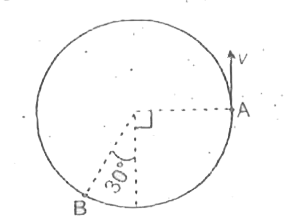A particle moves with constant speed v along a regular hexagon ABCDEF in the same order. Then the magnitude of the avergae velocity for its motion form A to
F is v/5
D is v/3
C is v√3/2
B is v
The correct Answer is:A, C, D
To solve the problem of finding the average velocity of a particle moving along a regular hexagon from point A to point F, we can follow these steps:
1. Understanding the Geometry of the Hexagon:
- A regular hexagon has six equal sides. Let the length of each side be x.
- The vertices of the hexagon are labeled as A, B, C, D, E, and F.
2. Determine the Displacement from A to F:
- The displacement from point A to point F can be visualized as a straight line connecting these two points.
- Since A and F are opposite vertices of the hexagon, the displacement is equal to the length of the line segment connecting A and F.
3. Calculating the Displacement:
- The distance from A to F can be calculated using the geometry of the hexagon. The distance is equal to 2x (the distance across the hexagon).
4. Calculate the Total Distance Traveled:
- The particle moves from A to B, B to C, C to D, D to E, and E to F. This is a total of 5 sides of the hexagon.
- Therefore, the total distance traveled is 5x.
5. Calculate the Total Time Taken:
- The speed of the particle is constant at v.
- The time taken to travel the total distance of 5x can be calculated using the formula:
\(
\text{Time} = \frac{\text{Distance}}{\text{Speed}} = \frac{5x}{v}
\)
6. Calculate the Average Velocity:
- The average velocity is defined as the total displacement divided by the total time taken.
- Thus, the average velocity \( V_{avg} \) can be calculated as follows:
\(
V_{avg} = \frac{\text{Displacement}}{\text{Time}} = \frac{2x}{\frac{5x}{v}} = \frac{2x \cdot v}{5x} = \frac{2v}{5}
\)
Final Result:
The magnitude of the average velocity of the particle from A to F is \( \frac{2v}{5} \).
---
- A regular hexagon has six equal sides. Let the length of each side be x.
- The vertices of the hexagon are labeled as A, B, C, D, E, and F.
- The displacement from point A to point F can be visualized as a straight line connecting these two points.
- Since A and F are opposite vertices of the hexagon, the displacement is equal to the length of the line segment connecting A and F.
- The distance from A to F can be calculated using the geometry of the hexagon. The distance is equal to 2x (the distance across the hexagon).
- The particle moves from A to B, B to C, C to D, D to E, and E to F. This is a total of 5 sides of the hexagon.
- Therefore, the total distance traveled is 5x.
- The speed of the particle is constant at v.
- The time taken to travel the total distance of 5x can be calculated using the formula:
\(
\text{Time} = \frac{\text{Distance}}{\text{Speed}} = \frac{5x}{v}
\)
- The average velocity is defined as the total displacement divided by the total time taken.
- Thus, the average velocity \( V_{avg} \) can be calculated as follows:
\(
V_{avg} = \frac{\text{Displacement}}{\text{Time}} = \frac{2x}{\frac{5x}{v}} = \frac{2x \cdot v}{5x} = \frac{2v}{5}
\)
The magnitude of the average velocity of the particle from A to F is \( \frac{2v}{5} \).
Similar Questions
Knowledge Check
A particle is moving with constant speed v along the line y = a in positive x -direction. Find magnitude of its angular velocity about orgine when its position makes an angle θ with x-axis.
Avsin2θaBvcos2θaCvsinθDNoneA particle moves with constant angular velocity in a circle. During the motion its
AEnergy is conservedBMomentum is conservedCEnergy and momentum both are conservedDNone of the above is conservedA particle is moving with a constant speed along a straight line path. A force is not required to
AIncrease its speedBDecrease the momentumCChange the directionDKeep it moving with uniform velocity
A particle moves with constant speed v along a circular path of radius r and completes the circle in time T. The acceleration of the particle is
View SolutionA particle is moving with a constant speed along a straight line path. A force is not requied to
View SolutionA particle is moving with constant speed v in xy plane as shown in figure. The magnitude of its angular velocity about point O is

View SolutionA particle is moving with a constant speed v in a circle. What is the magnitude of average velocity after half rotation?
View SolutionA particle is moving in a circle with a constant speed. Its moving is
View Solution

